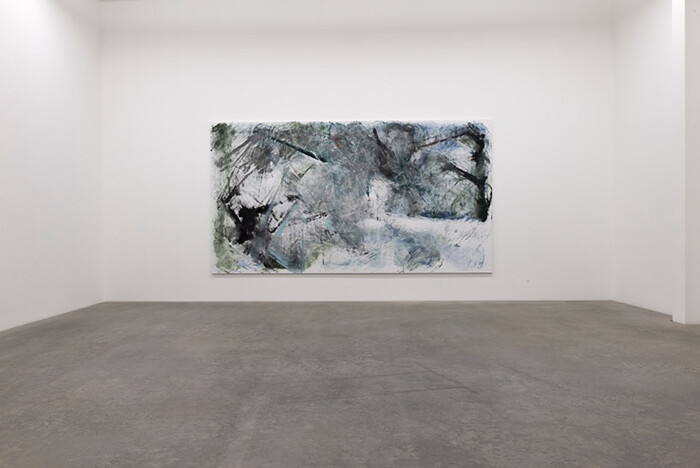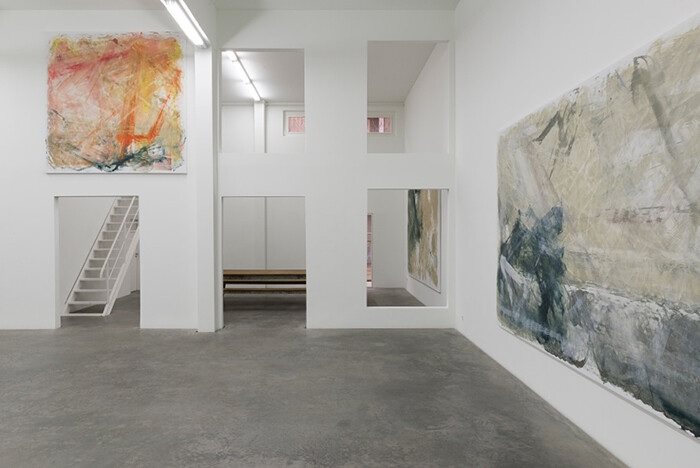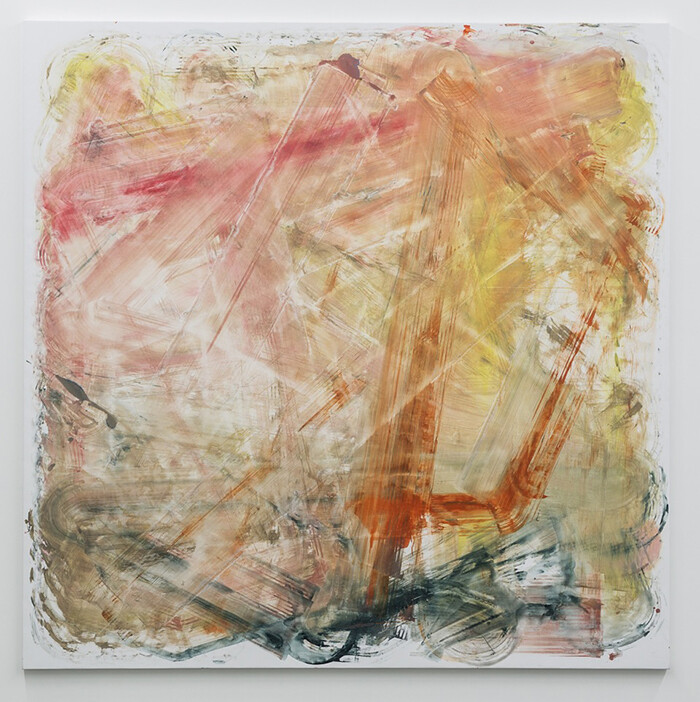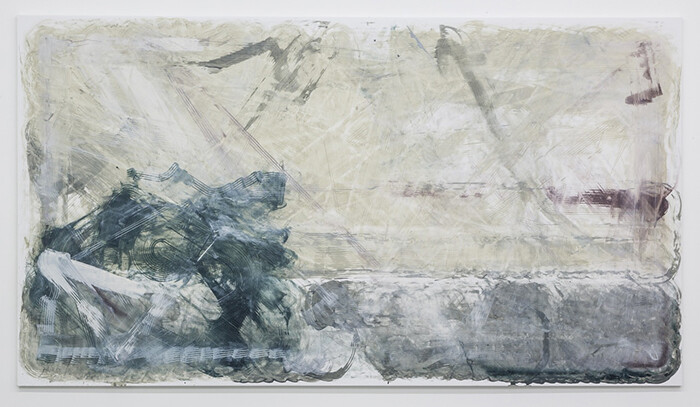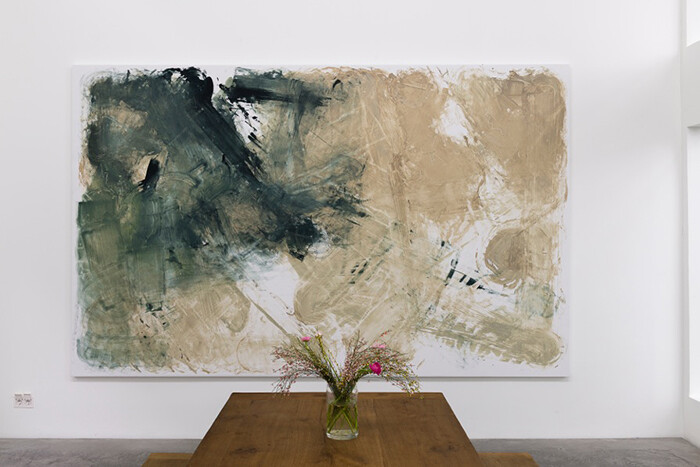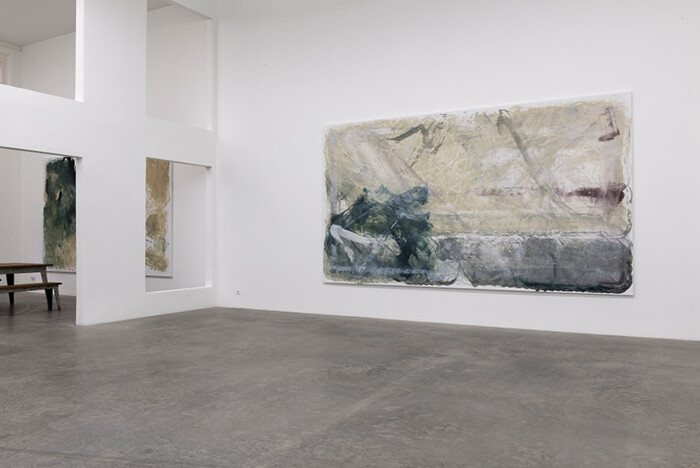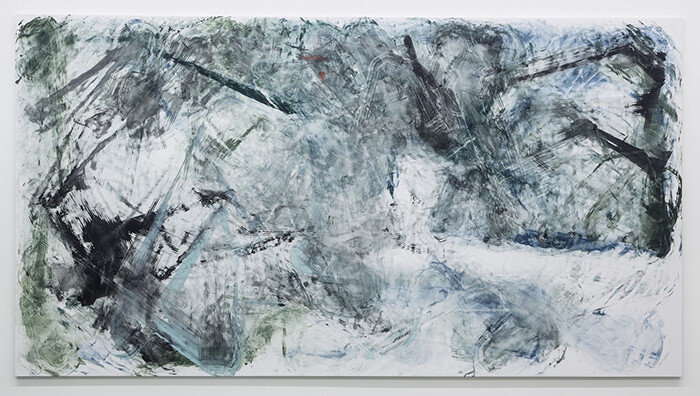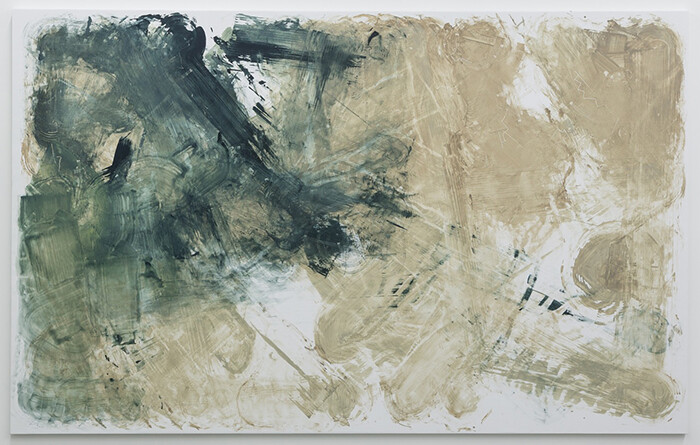We are all told again and again that in a more or less distant future, machines will take over—either in the form of an inverted big bang, a type of singularity, or over the course of a gradual transition. Even creative jobs will not be safe from the robot’s omnipotence. But for now, machine intelligence still has its limits.
In her most recent exhibition at Galerie Neu, the fictional artist Reena Spaulings (a collective of artists including, in this exhibition, John Kelsey, Jutta Koether, and Emily Sundbladt) shows four large-format paintings. All of the canvasses were colored by a floor-scrubbing robot called Scooba 450 and using high-end decorative wall paint colors with names like “Mouse’s Back” or “Smoked Trout.” One of the paintings is titled Bohemian Groove (all works 2015), a pun on the famous Californian all-male VIP resort Bohemian Grove. The other three all are titled Later Seascape, a reference to works of William Turner, the nineteenth-century English painter whose works became almost abstract in his later period. All the paintings on display in the gallery—and even some more of the same series, not exhibited here—were produced during the week leading up to the opening.
The show is not Reena Spaulings’s first exhibition of paintings produced in this way. Last year, she showed works of the same title at Campoli Presti in London. Another forerunner is a series of works Spaulings produced in 2011 using Yves Klein’s technique of the anthropométrie, which for Klein typically involved using naked female models as “living brushes.” Reena Spaulings used art historian Michael Sanchez as a human brush in what subsequently became the “Michael paintings.”
The position of machine-assisted art and automatic painting has changed radically over time, stuck between avant-garde ambitions and a critique of subjectivity. Coming closest to Reena Spaulings’s works are the paintings of Japanese artist Akira Kanayama, a member of the famous Gutai group. In 1957, he put a can of paint on a four-wheel electric toy car and let it cruise a canvas to create a series of “Remote-Control Paintings” (1957). There is one striking difference in the work of Reena Spaulings, or maybe not so striking. “Not surprisingly, the resulting pictures were of no great interest,” writes Yve-Alain Bois about Kanayama’s work. “But the Gutai artists knew as much and, initially at least, they did not particularly value these remnants.”1 He goes on to explain how the artistic production of the group lost its intellectual rigor and conceptual strength once its members discovered that their works could actually be seen and marketed as an extension of abstract painting, rather than a critique of it. Today, as these ideological conflicts of modernism have been replaced by affirmative references, intellectual posing, and soft appropriation, the issue of commodification remains a welcome and not much disputed side effect of experiments formerly known as conceptual.
Kanayama’s works mark by no means a starting point in the contested relationship between art and machinery. There was a whole epoch from the late sixteenth- to the late eighteenth-century in which the appreciation of antique sculpture could be merged with a curiosity for contemporary machinery and mechanical toys. Little is left of that discourse in popular memory, apart from the philosopher Julien Offray de La Mettrie and his 1748 book L’homme machine. In a knowledgeable treatise, the art historian Horst Bredekamp showed how the Baroque collection typically housed sculptures, paintings, treasuries of all sorts, and mechanical gadgets and toys.2 It was considered sophisticated to enhance the experience of artworks by adding mechanical elements like moving parts and light effects. Then came the pre-modern museum, which sanitized the old collections according to the ideas of Johann Joachim Winckelmann and his emphasis on the artist’s subjectivity. Ever since, mechanical gadgets have been excluded as soulless and un-subjective products that don’t merit consideration in the reflective circle of enlightened aesthetic self-education. From then onward, machines were expelled from the modern museum and could only be reintroduced under the guise of a conceptual twist. Now, as modernism has come to an end, this invisible wall has collapsed and the robots are starting to sneak back in.
At some point, a critique could examine the images more closely, those examples of “Roomba-painted Zombie Abstraction,” as Karen Archey put it.3 In this case, though, it seems more appropriate to let true connoisseurs of robot work speak, as does, for example, Amazon’s power user MJ23447: “I’ve watched the robot work a few times now and I really don’t like the algorithm it uses. It inexplicably covers the same part of the floor over and over and over while almost ignoring other parts. It really makes no sense and does not seem intelligent at all as it rams into the same obstacles (quite hard) again and again.”4
Yve-Alain Bois, Benjamin HD Buchloh, Hal Foster, and Rosalind Krauss, Art since 1900: Modernism, Antimodernism, Postmodernism (London: Thames & Hudson, 2004), 374.
Horst Bredekamp, Antikensehnsucht und Maschinenglauben (Berlin: Wagenbach, 1993).
Karen Archey, “Exhibition Tour: Reena Spaulings, ‘Later Seascapes’ at Galerie Neu, Berlin,” e-flux conversations, last modified February 23, 2015. http://conversations.e-flux.com/t/exhibition-tour-reena-spaulings-later-seascapes-at-galerie-neu-berlin/1039.
Amazon user MJ23447, “Excellent if your room floors are perfectly flat and either 150 or 300 sq/ft,” Amazon.com, last modified April 26, 2014. http://www.amazon.com/review/RPB02T4R92MR.
